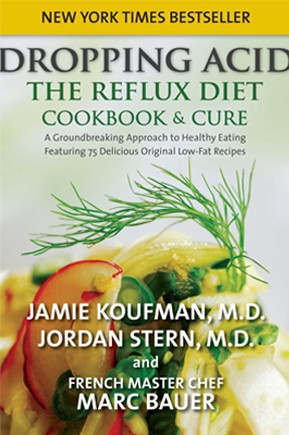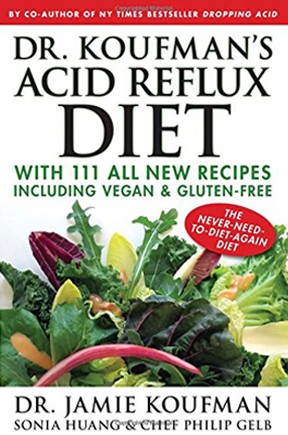At-A-Glance
- Using fewer egg yolks helps retain flavor while lowering fat content in a reflux-friendly omelet.
- Lightly sauté all vegetables before adding them to improve digestibility.
- Avoid common reflux triggers like onions, bell peppers, and processed meats.
- Choose gentle protein additions such as smoked salmon or extra egg whites.
- Prepare vegetables at dinner the night before to simplify your morning breakfast.
Join Dr Jamie Koufman on Facebook Live at noon EST on the first Wednesday of each Month. If you miss it live, you can also see it on YouTube.
Eggs are a staple across many cultures—in the American breakfast tradition, they’re beloved for their versatility and flavor. But, if you’re managing acid reflux, you may wonder if eggs can be part of a reflux-friendly breakfast. The answer lies not only in the egg itself, but also in the ingredients you choose to have with it. Let’s talk about how to enjoy a reflux-friendly omelet.
The Science Behind Eggs and Reflux
For anyone suffering from reflux, the general recommendation is to avoid highly acidic and fatty foods. While eggs are not acidic, the egg yolks are rich in fat. Fatty foods tend to relax the lower esophageal sphincter, which keeps the stomach contents from traveling up the esophagus, and delay stomach emptying, which can aggravate reflux.
However, egg yolks are also high in essential nutrients such as choline (important for brain and liver function), selenium, and antioxidants like lutein and zeaxanthin. For this reason, egg yolks are not unhealthy—on the contrary, they are nutrient-dense. But because of their fat content, those who are managing reflux should have them in moderation.
A Reflux-Friendly Egg Formula
Instead of eliminating yolks entirely, a more balanced approach is to reduce the yolk-to-white ratio when preparing an omelet. This preserves flavor and retains some valuable nutrients, while lowering overall fat content.
A helpful formula is: One yolk for every three eggs.
This can be adapted depending on your portion size:
- For a 3-egg omelet: use 1 yolk + 3 egg whites
- For a 6-egg batch: use 2 yolks + 6 egg whites
If you’re new to making omelets or want a refresher, this step-by-step tutorial provides a helpful foundation. Once you have the technique down, you can customize with ingredients of your choosing.
Best Ingredients for a Reflux-Friendly Omelet
When it comes to fillings, the key is choosing proper ingredients. Many traditional omelet add-ins—such as onions, peppers, and processed meats—are common reflux triggers due to their acidity, fat content, or tendency to cause gas and bloating.
Instead, focus on soft, low-acid vegetables and lean proteins, all of which should be lightly sautéed before adding to your omelet. Cooking vegetables in advance softens their fibers and enhances digestibility, an important consideration for those with reflux.
Reflux-Friendly Vegetables (sautéed first):
- Mushrooms
- Asparagus
- Carrots
- Green beans
- Peas
Lean Protein Additions:
- Smoked salmon (lox) – well-tolerated by many and rich in flavor
- Additional egg whites – boost protein without adding extra fat
By sautéing vegetables ahead of time and skipping common triggers, you can build a nourishing, flavorful omelet that is unlikely to cause reflux.
A Practical Cooking Tip
Many people find it helpful to cook extra vegetables at dinner and set some aside for the next morning’s omelet. This saves time and makes it easy to enjoy a nourishing, reflux-friendly breakfast the next day.
Canned vegetables can also be convenient options to keep on hand, but they should still be gently cooked before folding into the eggs.
Omelets Around the World: A Global Take on a Classic Dish
It’s worth noting that omelets are a staple in cuisines around the world, each culture bringing its own unique ingredients, techniques, and meaning to this simple dish.
- In France, the classic omelette nature is soft, pale, and barely set—delicately folded with herbs or cheese. It’s a test of precision in French culinary schools.
- In Japan, tamagoyaki is a sweet rolled omelet made with soy sauce and mirin. Carefully layered and often served with sushi, it’s known for its pillowy texture and balance of flavor.
- In Spain, the hearty tortilla española is made with eggs, potatoes, and sometimes onions. Thicker and denser than most omelets, it’s served warm or at room temperature and often enjoyed as a tapa.
- In Iran, kuku sabzi is a vibrant herb-packed omelet traditionally served during Nowruz (Persian New Year). It’s loaded with greens like parsley, cilantro, and dill—celebrating the arrival of spring and new life.
- In Thailand, khai jiao is a crispy, golden omelet made with fish sauce and served over jasmine rice. It’s a popular street food and comfort dish, often topped with chili sauce or fresh herbs.
These global variations show just how adaptable and beloved the omelet is, across both cultures and dietary needs. Even when managing reflux, there are still ways to enjoy this timeless food, with proper modifications.
Conclusion
A reflux-friendly omelet doesn’t have to be bland or restrictive. With just a few adjustments—like using fewer yolks and selecting well-cooked, gentle ingredients that are not on the reflux trigger list—you can enjoy a breakfast that honors both your health and your taste buds. It’s a small way to bring enjoyment to your mornings—without compromising your health.
For more information about diagnosis and treatment of acid reflux, see two companion books on Amazon: Dr. Koufman’s Acid Reflux Diet and Dropping Acid: The Reflux Diet Cookbook & Cure. If you would like to receive personalized guidance and strategies for lasting relief, consider scheduling an online consultation.










